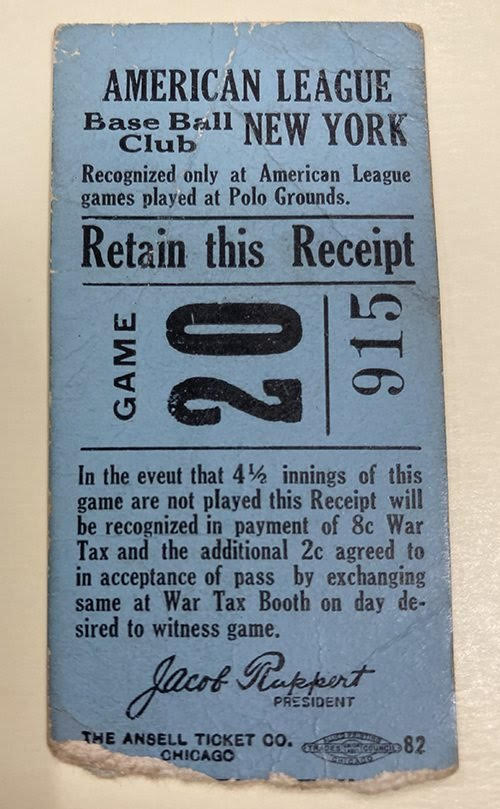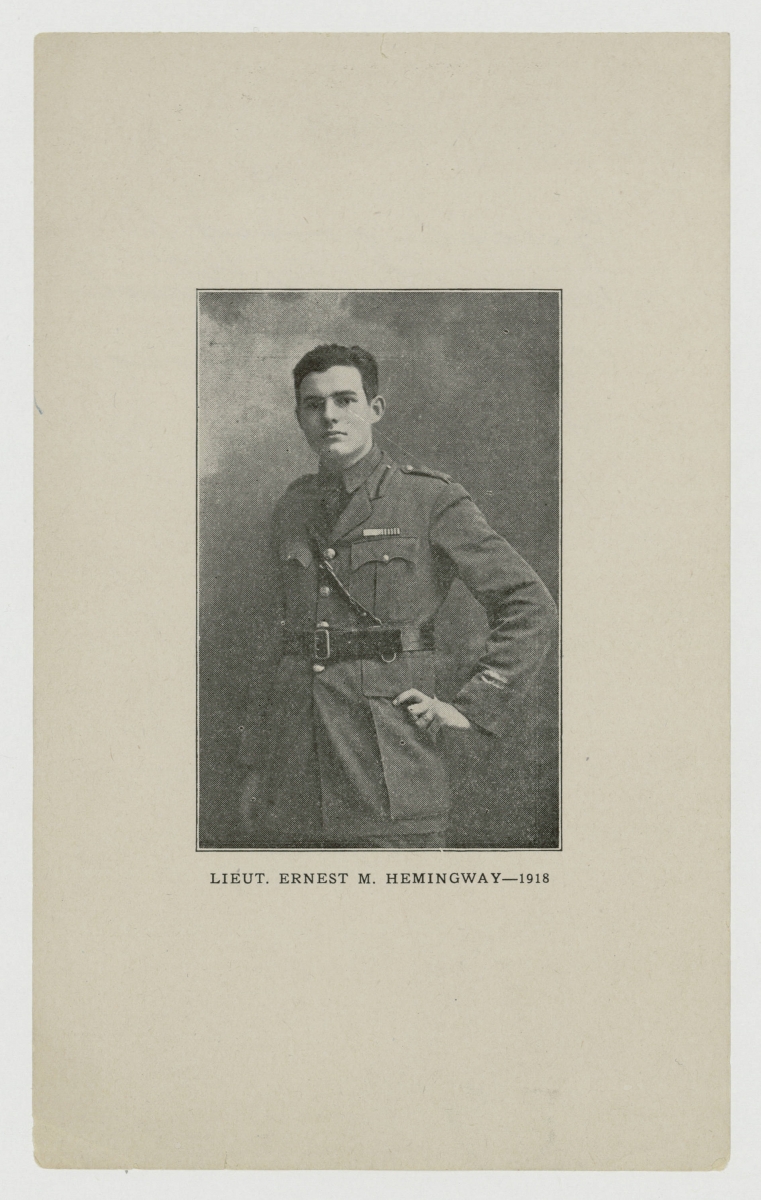
Hemingway's baseball ticket stub
from the Ernest Hemingway Foundation of Oak Park Archives
When archivist Kheir Fakhreldin began a new job working at the Hemingway Archives in Oak Park Public Library's Special Collections, he noticed a remarkable item contained within the collection: a baseball ticket stub Ernest Hemingway carried into war. Before going to Italy in the spring of 1918 to serve as a Red Cross volunteer, one of the last things Hemingway did while still on American soil was to attend a baseball game.
Not just any game, the match-up Hemingway saw on May 22 in New York involved his hometown Chicago White Sox facing off at the Polo Grounds against the New York Yankees. Hemingway enjoyed this last taste of Americana while awaiting a ship that would depart the next day, taking him to Europe and to war. Only a few weeks later, he would be seriously injured while delivering chocolates and cigarettes to soldiers on the front line. It must have meant a lot to Hemingway to see this ballgame because he kept the ticket stub safe through his injury, his evacuation to a Red Cross hospital in Milan, his relocation to Stresa for recuperation, and then—upon discharge from his Red Cross service—back home.

Ernest Hemingway formal military photograph, 1918, courtesy of the Ernest Hemingway Foundation of Oak Park in cooperation with the Oak Park Public Library: The Early Years - Ernest and Marcelline Hemingway in Oak Park (Illinois Digital Archives), 1918, http://www.idaillinois.org/digital/collection/p16614coll27/id/345. 2023-08-21
It makes sense that this physical object meant so much to Hemingway because not only would it have symbolized his country to him, but it also provided a tangible link to his family and to a childhood joy. One of the earliest of Hemingway’s known letters contains a request to his father Clarence, also a baseball fan, asking to be taken to a Chicago Cubs game.1 And a fascinating find at Wheaton College shows that this particular passion crossed generations. A primitive baseball box score circa 1868-1869 discovered in the college's archives reveals that Ernest’s paternal grandfather, Anson Hemingway, had been a very early practitioner of baseball. Anson attended Wheaton, where he played third base, after serving in the Civil War.
Connection to country, his family, childhood innocence, and a sport that he loved, all appear bound up in the ticket stub Hemingway took with him to Italy and so carefully preserved through the chaos of war and injury to bring safely home. Sean Kolodziej of the Society of American Baseball Research has published an article on the story of the game linked to that ticket stub, the match Hemingway witnessed just before he left America for an uncertain future.
This article captures details of the weather, the crowd, the plays, and the players Hemingway observed that day—including White Sox pitcher Eddie Cicotte who, just a year later, became involved in one of the greatest baseball scandals of all time. Cicotte was one of the notorious “Black Sox” players accused of conspiring with gamblers to throw the 1919 World Series. That day, though, all of that, like Hemingway’s own wounding, remained in the future, unknown to Ernest as he experienced the plays and the drama of America’s National Pastime one last time before crossing an ocean to witness battle on a different field.
Works Cited
Fakhreldin, Kheir. “Hemingway and baseball: A stub to remember.” Journal of Oak Park and River Forest (July 12, 2022): https://www.oakpark.com/2022/07/12/hemingway-and-baseball-a-stub-to-remember/
Hamilton, Sharon. “Ernest Hemingway and the Black Sox Trial.” Society for American Baseball Research: sabr.org/research/article/ernest-hemingway-and-the-black-sox-trial/
---. “Hemingway gambles, loses on 1919 White Sox.” Society for American Baseball Research Black Sox Scandal Research Committee Newsletter (June 2020), 12-14. Rpt. by the Michigan Hemingway Society: https://www.michiganhemingwaysociety.org/pdfdocs/Hemingway%20Gambles%20and%20Loses%20on%201919%20World%20Series.pdf
Hemingway, Ernest. Letter to Clarence Hemingway [c. second week of May 1912] in Ernest Hemingway, The Letters of Ernest Hemingway, 1907-1922, Volume 1. Edited by Sandra Spanier and Robert W. Trogdon (Cambridge: Cambridge University Press, 2011), 12.
Kolodziej, Sean. “For Whom the Ballgame Tolls: Ernest Hemingway Attends A White Sox Game Before Shipping Off to War.” Society for American Baseball Research: https://sabr.org/journal/article/for-whom-the-ballgame-tolls-ernest-hemingway-attends-a-white-sox-game-before-shipping-off-to-war/#calibre_link-711
Malone, David. “Play Ball!!” Daily Archives [Wheaton College] (March 31, 2011): https://recollections.wheaton.edu/2011/03/31/
1Ernest Hemingway, letter to Clarence Hemingway [c. second week of May 1912] in Ernest Hemingway, The Letters of Ernest Hemingway, 1907-1922, Volume 1. Edited by Sandra Spanier and Robert W. Trogdon (Cambridge: Cambridge University Press, 2011), 12.
Sharon Hamilton is a member of the Hemingway Society Board. She has blogged previously for the Hemingway Society about visiting Hemingway and Hadley’s Chicago Apartment and about Hemingway’s New Orleans.